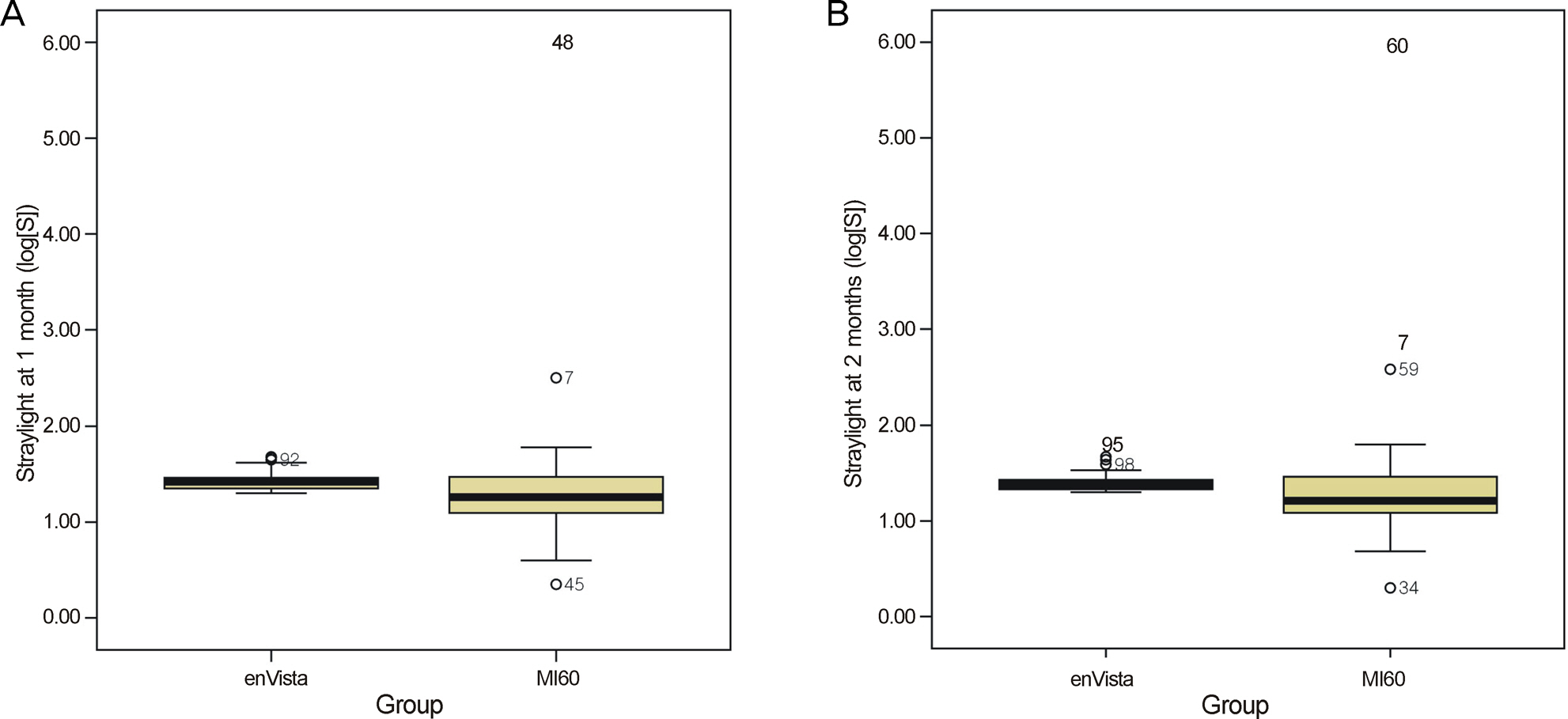J Korean Ophthalmol Soc.
2014 Jul;55(7):1001-1006.
Effect of Glistening-Free Intraocular Lens on Intraocular Straylight
- Affiliations
-
- 1Department of Ophthalmology and Visual Science, Yeouido St. Mary's Hospital, The Catholic University of Korea College of Medicine, Seoul, Korea.
- 2Department of Ophthalmology and Visual Science, Incheon St. Mary's Hospital, The Catholic University of Korea College of Medicine, Seoul, Korea.
- 3Department of Ophthalmology and Visual Science, St. Paul's Hospital, The Catholic University of Korea College of Medicine, Seoul, Korea. eyedoc@catholic.ac.kr
Abstract
- PURPOSE
To compare intraocular straylight between glistening-free and conventional intraocular lenses in pseudophakic eyes.
METHODS
Straylight values were measured prospectively in 21 eyes with glistening-free pseudophakic lenses (group A, model enVista(TM), Bausch & Lomb, Inc., USA) and 79 eyes with conventional hydrophilic pseudophakic lenses (group B, model Akreos MI-60, Bausch & Lomb, Inc., USA). Best corrected visual acuity (BCVA) and straylight were measured preoperatively and 1 month and 2 months postoperatively using C-quant straylight meter (Oculus GmbH, Wetzlar, Germany).
RESULTS
There were no statistically significant differences of BCVA preoperatively or 2 months postoperatively between the 2 groups (p > 0.05). BCVA and straylight significantly improved after the operation (p < 0.05). The mean straylight values were 1.43 +/- 0.12 (log[s]) and 1.41 +/- 0.16 (log[s]) for group A, and 1.33 +/- 0.61 (log[s]) and 1.40 +/- 0.82 (log[s]) for group B at postoperative 1 month and 2 months, respectively, with no statistical significance between the 2 groups (p > 0.05).
CONCLUSIONS
In terms of straylight, glistening-free intraocular lenses were not beneficial. Although straylight was not statistically significant, other correlations between glistening and visual function should be investigated.
Keyword
Figure
Reference
-
References
1. Gregori NZ, Spencer TS, Mamalis N, Olson RJ. In vitro comparison of glistening formation among hydrophobic acrylic intraocular lenses. J Cataract Refract Surg. 2002; 28:1262–8.
Article2. Tognetto D, Toto L, Sanguinetti G, Ravalico G. Glistenings in foldable intraocular lenses. J Cataract Refract Surg. 2002; 28:1211–6.
Article3. Colin J, Orignac I. Glistenings on intraocular lenses in healthy eyes: effects and associations. J Refract Surg. 2011; 27:869–75.
Article4. Oshika T, Shiokawa Y, Amano S, Mitomo K. Influence of glistenings on the optical quality of acrylic foldable intraocular lens. Br J Ophthalmol. 2001; 85:1034–7.
Article5. Werner L, Storsberg J, Mauger O, et al. Unusual pattern of glistening formation on a 3-piece hydrophobic acrylic intraocular lens. J Cataract Refract Surg. 2008; 34:1604–9.
Article6. Gunenc U, Oner FH, Tongal S, Ferliel M. Effects on visual function of glistenings and folding marks in AcrySof intraocular lenses. J Cataract Refract Surg. 2001; 27:1611–4.
Article7. Christiansen G, Durcan FJ, Olson RJ, Christiansen K. Glistenings in the AcrySof intraocular lens: pilot study. J Cataract Refract Surg. 2001; 27:728–33.
Article8. Franssen L, Coppens JE, van den Berg TJ. Compensation comparison method for assessment of retinal straylight. Invest Ophthalmol Vis Sci. 2006; 47:768–76.
Article9. Kato K, Nishida M, Yamane H, et al. Glistening formation in an AcrySof lens initiated by spinodal decomposition of the polymer network by temperature change. J Cataract Refract Surg. 2001; 27:1493–8.10. Saylor DM, Coleman Richardson D, Dair BJ, Pollack SK. Osmotic cavitation of elastomeric intraocular lenses. Acta Biomater. 2010; 6:1090–8.
Article11. Nishihara H, Kageyama T, Ohnishi T, et al. Glistenings in lathe-cut acrylic intraocular lens. Ganka Shujutsu. 2000; 13:227–30.12. Omar O, Pirayesh A, Mamalis N, Olson RJ. In vitro analysis of AcrySof intraocular lens glistenings in AcryPak and Wagon Wheel packaging. J Cataract Refract Surg. 1998; 24:107–13.
Article13. Dick HB, Olson RJ, Augustin AJ, et al. Vacuoles in the AcrySof in- traocular lens as factor of the presence of serum in aqueous humor. Ophthalmic Res. 2001; 33:61–7.14. Ayaki M, Nishihara H, Yaguchi S, Koide R. Effect of ophthalmic solution components on acrylic intraocular lenses. J Cataract Refract Surg. 2007; 33:122–6.
Article15. Colin J, Orignac I, Touboul D. Glistenings in a large series of hydrophobic acrylic intraocular lenses. J Cataract Refract Surg. 2009; 35:2121–6.
Article16. Hayashi K, Hirata A, Yoshida M, et al. Long-term effect of surface light scattering and glistenings of intraocular lenses on visual function. Am J Ophthalmol. 2012; 154:240–51.
Article17. Elliott DB, Bullimore MA. Assessing the reliability, discriminative ability, and validity of disability glare tests. Invest Ophthalmol Vis Sci. 1993; 34:108–19.18. IJspeert JK, de Waard PW, van den Berg TJ, de Jong PT. The intraocular straylight function in 129 healthy volunteers; dependence on angle, age and pigmentation. Vision Res. 1990; 30:699–707.
Article19. Behndig A, Mönestam E. Quantification of glistenings in intraocular lenses using Scheimpfl ug photography. J Cataract Refract Surg. 2009; 35:14–7.20. Mackool RJ, Colin J. Limitations of Scheimpflug photography in quantifying glistenings. J Cataract Refract Surg. 2009; 35:1480–1.
Article21. Van Den Berg TJ, Van Rijn LJ, Michael R, et al. Straylight effects with aging and lens extraction. Am J Ophthalmol. 2007; 144:358–63.
Article
- Full Text Links
- Actions
-
Cited
- CITED
-
- Close
- Share
- Similar articles
-
- Comparison of Intraocular Straylight in Patients with Clear and Photochromic Intraocular Lenses
- Straylight in Normal and Cataractous Eyes of Koreans
- Two Cases of Intraoperative Acute Opacification of Hydrophilic Intraocular Lens
- Intraocular Lens Scleral Fixation by Flanged Fixation Using 5-0 Polyprophylene
- Posterior Chamber Intraocular Lens Implantation in High Myopia



